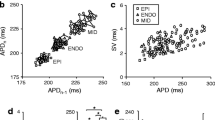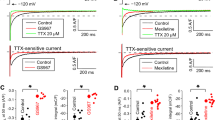Summary
-
1.
The negative inotropic effect and the effect on action potential configuration were investigated for TTX and 7 class 1 antiarrhythmic drugs (aprindine, AR-LH 31, CCI 22277, disopyramide, mexiletine, quinidine and sparteine) in the isolated guinea-pig papillary muscle contracting at 1 Hz.
-
2.
The ratio of the molar concentration producing 50% reduction of \(\dot V_{\max } \) to that reducing force of contraction by 50% ranged from 0.23 (sparteine) to 2.2 (disopyramide) showing that some of the drugs were more potent Na channel blockers than negative inotropic agents, while the reverse was true for others.
-
3.
With the exceptions of sparteine and AR-LH 31, all the drugs produced a larger negative inotropic effect than TTX at concentrations equieffective in reducing \(\dot V_{\max } \). Thus, blockade of Na channels can account for only part of the negative inotropic effect of aprindine, CCI 22277, disopyramide, mexiletine and quinidine. Even sparteine and AR-LH 31 showed a negative inotropic property independent of Na channel blockade because, unlike TTX and like all other agents, they retained their negative inotropic activity after inactivation of Na channels by elevated extracellular K concentration (24 mmol/l).
-
4.
Relative negative inotropic effects of lorcainide, Org 6001 and propafenone were similar at 5.9 and 24 mmol/l (K)o. In contrast, the-log molar IC50(F c) of flecainide, prajmalium bitartrate and tocainide was significantly decreased (by 0.35 to 0.81 log units) if Na channels were inactivated by K depolarization.
-
5.
Ouabain-sensitive Na,K-ATPase was not inhibited by sparteine, while mexiletine and AR-LH 31 produced partial inhibition (each at 1 mmol/l).
-
6.
We conclude that the negative inotropic effect of class 1 antiarrhythmic drugs represents the sum of their Na channel blocking and additional drug-dependent inotropic properties. Quinidine, aprindine and mexiletine appear to be combined Na channel and Ca channel inhibiting agents thus causing a larger negative inotropic effect than TTX. However, a superimposed positive inotropic mechanism may also be operative in some antiarrhythmic drugs (sparteine, AR-LH 31, high concentrations of mexiletine).
Similar content being viewed by others
Abbreviations
- F c :
-
peak force of contraction
- t 1 :
-
time to peak force
- t 2 :
-
relaxation time
- S 1 :
-
maximum rate of force development
- APA:
-
amplitude of action potential
- APD30 and APD90 :
-
duration of action potential at 30 and 90% repolarization
- \(\dot V_{\max } \) :
-
maximum rate of depolarization of action potential
- RMP:
-
resting membrane potential
- AR-LH 31:
-
8-(3-diethylaminopropyl)-6,6-dimethyl-2-phenyl-1H-imidazo(4,5-h)isoquinoline-7,9(6H,8H)-dione dihydrochloride
- CCI 22277:
-
methyl 2β-ethoxy-3α-hydroxy-11α-(3-methyl-butylamino)-5α-androstane-17β-carboxylate hydrochloride
- DMSO:
-
dimethylsulphoxide
- Na,K(Mg)-ATPase:
-
guineapig ventricular sodium-, potassium-(magnesium-)activated adenosine triphosphatase (EC 3.6.1.3)
- Org 6001:
-
3α-amino-2β-hydroxy-5α-androstan-17-one hydrochloride
- TTX:
-
tetrodotoxin
References
Baer M, Best PM, Reuter H (1976) Voltage-dependent action of tetrodotoxin in mammalian cardiac muscle. Nature (Lond) 263:344–345
Baker RJ, Nelder JA (1978) General linear interactive modelling (GLIM). Release 3. Numerical algorithms group, Oxford
Bigger JT (1984) Identification of patients at high risk for sudden cardiac death. Am J Cardiol 54:3D-8D
Borchard U, Fox AAL, Greeff K (1980) The positive inotropic, antiarrhythmic and Na+,K+-ATPase inhibitory effects of the isoquinoline derivative, BIIA. Naunyn-Schmiedeberg's Arch Pharmacol 312:187–192
Campbell TJ, Vaughan Williams EM (1982) Electrophysiological and other effects on rabbit hearts of CCI 22277, a new steroidal antiarrhythmic drug. Br J Pharmacol 76:337–345
Carmeliet E, Verdonck F (1974) Effects of aprindine and lidocaine on transmembrane potentials and radioactive K efflux in different cardiac tissues. Acta Cardiol (Suppl XVIII): 73–90
Cohen CJ, Bean BP, Tsien RW (1984) Maximal upstroke velocity as an index of available sodium conductance. Circ Res 54:636–651
Coraboeuf E, Vassort G (1968) Effects of some inhibitors of ionic permeabilities on ventricular action potential and contraction of rat and guinea-pig hearts. J Electrocardiol 1:19–30
Courtney KR (1984) Relationship between excitability block and negative inotropic actions of antiarrhythmic drugs. Proc West Pharmacol Soc 27:181–184
Cowan JC, Vaughan Williams EM (1981) Characterization of a new oral antiarrhythmic drug, flecainide (R818). Eur J Pharmacol 73:333–342
Deitmer JW, Ellis D (1980) The intracellular sodium activity of sheep heart Purkinje fibres: Effects of local anaesthetics and tetrodotoxin. J Physiol (Lond) 300:269–282
Ducouret P (1976) The effect of quinidine on membrane electrical activity in frog auricular fibres studied by current and voltage clamp. Br J Pharmacol 57:163–184
Ehring GR, Hondeghem LM (1978) Rate, rhythm and voltage dependent effects of phenytoin: a test of a model of the mechanisms of action of antiarrhythmic drugs. Proc West Pharmacol Soc 21:63–65
Eisner DA, Lederer WJ, Sheu S-S (1983) The role of intracellular sodium activity in the anti-arrhythmic action of local anaesthetics in sheep Purkinje fibres. J Physiol (Lond) 340:239–257
Feinstein MB, Paimre M (1968) Mechanism of cardiovascular action of tetrodotoxin in the cat. Circ Res 23:553–565
Finney DJ (1971) Probit analysis. Cambridge University Press, Cambridge
Fox AAL, Greeff K (1981) Mechanism of inhibition of sodium-and potassium-dependent adenosine triphosphatase by the isoquinoline derivative BIIA: Specific interaction with sodium activation. Biochem Pharmacol 30:611–617
Fozzard HA, Wasserstrom JA (1985) Voltage dependence of intracellular sodium and control of contraction. In: Zipes DP, Jalife J (eds) Cardiac electrophysiology and arrhythmias Grune and Stratton, Crlando, pp 51–57
Halbach S, Schönsteiner G, Ebner F, Reiter M (1981) The effects of p-chloromercuriphenylsulfonic acid (PCMBS) on the force of contraction of mammalian myocardium and on ATP hydrolysis by sarcolemmal ATPase. Naunyn-Schmiedeberg's Arch Pharmacol 318:121–129
Hammermeister KE, Boerth RC, Warbasse JR (1972) The comparative inotropic effects of six clinically used antiarrhythmic agents. Am Heart J 84:643–652
Holck M, Thorens S, Muggli R, Eigenmann R (1984) Studies on the mechanism of positive inotropic activity of Ro 13-6438, a structurally novel cardiotonic agent with vasodilating properties. J Cardiovasc Pharmacol 6:520–530
Honerjäger P (1982) Cardioactive substances that prolong the open state of sodium channels. Rev Physiol Biochem Pharmacol 92:1–74
Honerjäger P, Loibl E, Ulm K (1983) Does sodium channel blockade explain the negative inotropic effect of class 1 antiarrhythmic drugs? Naunyn-Schmiedeberg's Arch Pharmacol 322:R30
Honerjäger P, Reiter M (1975) The relation between the effects of veratridine on action potential and contraction in mammalian ventricular myocardium. Naunyn-Schmiedeberg's Arch Pharmacol 289:1–28
January CT, Fozzard HA (1984) The effects of membrane potential, extracellular potassium, and tetrodotoxin on the intracellular sodium ion activity of sheep cardiac muscle. Circ Res 54:652–665
Kerr MJ, Harron DWG, Wilson R, Shanks RG (1985) Effect of 8-(3-diethylaminopropyl)-6,6-dimethyl-[2-phenyl-1H-imidazo-(4,5h)]-isoquinoline-7,9-(6H)dionedihydrochloride(AR-LH31) on experimental cardiac arrhythmias in dogs. Arzneimittelforsch 35:197–200
Mantelli L, Manzini S, Mugelli A, Ledda F (1981) The influence of some cardiodepressant drugs on the histamine-induced restoration of contractility in potassium-depolarized heart preparations. Arch Int Pharmacodyn 254:99–108
Mullins LJ (1981) Ion transport in heart. Raven Press, New York
Nawrath H (1981) Action potential, membrane currents and force of contraction in mammalian heart muscle fibers treated with quinidine. J Pharmacol Exp Ther 216:176–182
Podrid PJ, Schoeneberger A, Lown B (1980) Congestive heart failure caused by oral disopyramide. N Engl J Med 302:614–617
Raschack M (1974) Wirkungen von Spartein und Sparteinderivaten auf Herz und Kreislauf. Arzneimittelforsch 24:753–759
Reiter M (1967) Die Wertbestimmung inotrop wirkender Arzneimittel am isolierten Papillarmuskel. Arzneimittelforsch 17:1249–1253
Savigny L, Rüdiger HJ, Haap KP, Antoni H (1981) Elektrophysiologische Studien zur Wirkung von Mexiletin auf das isolierte Säugetiermyocard. In: Lüderitz B (ed) Ventrikuläre Herzrhythmusstörungen. Springer, Berlin Heidelberg New York, pp 197–206
Scholz H (1969) Ca-abhängige Membranpotentialänderungen am Herzen und ihre Bedeutung für die elektro-mechanische Kopplung. Versuche mit Tetrodotoxin in Na-haltigen Lösungen. Naunyn-Schmiedeberg's Arch Pharmacol 265:187–204
Senges J, Ehe L (1973) The effects of sparteine on membrane potential and contraction of mammalian heart muscle. Naunyn-Schmiedeberg's Arch Pharmacol 280:253–264
Shigenobu K, Atoda H, Asano T, Kasuya Y (1980) Electrophysiological effects of a new antiarrhythmic agent, lorcainide, on the isolated cardiac muscle fiber as compared with disopyramide. J Pharmacobiodyn 3:677–685
Su JY, Libao RG (1984) Intracellular mechanism of quinidine action on muscle contraction. A comparison between rabbit cardiac and skeletal muscle. Naunyn-Schmiedeberg's Arch Pharmacol 326:375–381
Taira N, Endoh M, Iijima T, Satoh K, Yanagisawa T, Yamashita S, Maruyama M, Kawada M, Morita T, Wada Y (1984) Mode and mechanism of action of 3,4-dihydro-6-[4-(3,4-dimethoxybenzoyl)-l-piperazinyl]-2(lH)quinolinone (OPC-8212), a novel positive inotropic drug, on the dog heart. Arzneimittelforsch 34:347–355
Trautwein W, Pelzer D, McDonald TF, Osterrieder W (1981) AQA 39, a new bradycardic agent which blocks myocardial calcium (Ca) channels in a frequency-and voltage-dependent manner. Naunyn-Schmiedeberg's Arch Pharmacol 317:228–232
Vassalle M, Bhattacharyya M (1980) Local anesthetics and the role of sodium in the force development by canine ventricular muscle and Purkinje fibers. Circ Res 47:666–674
Vaughan Williams EM (1984a) A classification of antiarrhythmic actions reassessed after a decade of new drugs. J Clin Pharmacol 24:129–147
Vaughan Williams EM (1984b) Subgroups of class 1 antiarrhythmic drugs. Eur Heart J 5:96–98
Author information
Authors and Affiliations
Additional information
Part of this work is included in the theses of E. Loibl and I. Steidl, Technische Universität München
Supported by the Deutsche Forschungsgemeinschaft (Ho 705/6)
Rights and permissions
About this article
Cite this article
Honerjäger, P., Loibl, E., Steidl, I. et al. Negative inotropic effects of tetrodotoxin and seven class 1 antiarrhythmic drugs in relation to sodium channel blockade. Naunyn-Schmiedeberg's Arch. Pharmacol. 332, 184–195 (1986). https://doi.org/10.1007/BF00511411
Received:
Accepted:
Issue Date:
DOI: https://doi.org/10.1007/BF00511411




